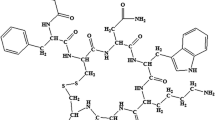Abstract.
Somatostatin receptor-positive lesions can be visualized by scintigraphy using [111In-DTPA0]octreotide. Recently, there have been reports of differences in receptor binding between somatostatin receptor subtypes and between somatostatin analogues, such as RC-160 and octreotide, as well as of differences in internalization between the somatostatin receptor subtypes. The possibility that certain somatostatin receptor-positive tissues and tumours which do not bind octreotide may bind and internalize RC-160 would open new scintigraphic or radiotherapeutic applications of radiolabelled RC-160. We investigated the metabolism and tissue distribution of [111In-DTPA0]RC-160 in comparison with [111In-DTPA0]octreotide in four patients after injection of 250 MBq (10 μg) of these radiopharmaceuticals. Patient 1 had a metastatic follicular thyroid carcinoma, patient 2 a metastatic medullary thyroid carcinoma, patient 3 tuberculosis and patient 4 an insulinoma. The plasma clearance of the [111In-DTPA0]RC-160 was slower than that of [111In-DTPA0]octreotide, with 5% and 2%, respectively, of the initial plasma radioactivity remaining at 10 h p.i. The urinary excretion of [111In-DTPA0]RC-160 was initially also slower than that of [111In-DTPA0]octreotide, but the cumulative excretion of radioactivity was not significantly different at 48 h p.i. Approximately 80% of injected radioactivity was cleared in the urine, while in one patient 20% of the injected dose was recovered in the faeces. The slower clearance of [111In-DTPA0]RC-160 resulted in a higher background in all organs studied i.e. liver, spleen, kidneys and lungs, at 24 h p.i. Although the target to background ratio with [111In-DTPA0]octreotide was higher, no differences were found between the two analogues with regard to their sensitivity in detecting lesions in these four patients. We conclude that although only four subjects were studied, [111In-DTPA0]RC-160 does not appear to have additional value for scintigraphy and is associated with higher background activity.
Similar content being viewed by others
Author information
Authors and Affiliations
Additional information
Received 20 October and in revised form 31 October 1997
Rights and permissions
About this article
Cite this article
Breeman, W., van Hagen, P., Kwekkeboom, D. et al. Somatostatin receptor scintigraphy using [111In-DTPA0]RC-160 in humans: a comparison with [111In-DTPA0]octreotide. Eur J Nucl Med 25, 182–186 (1998). https://doi.org/10.1007/s002590050213
Issue Date:
DOI: https://doi.org/10.1007/s002590050213




